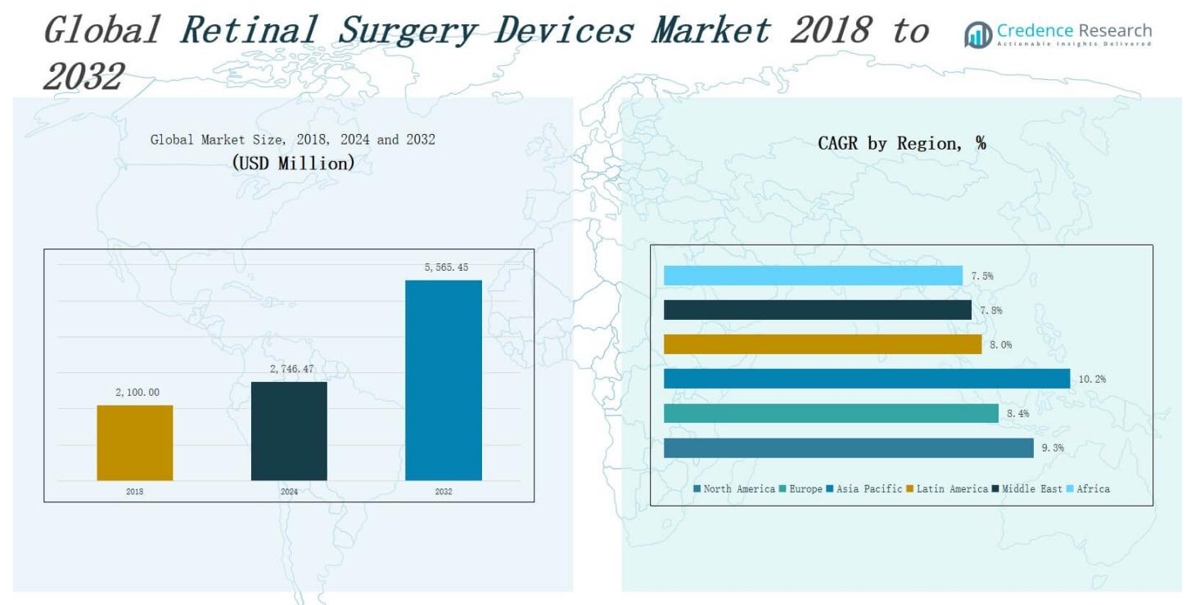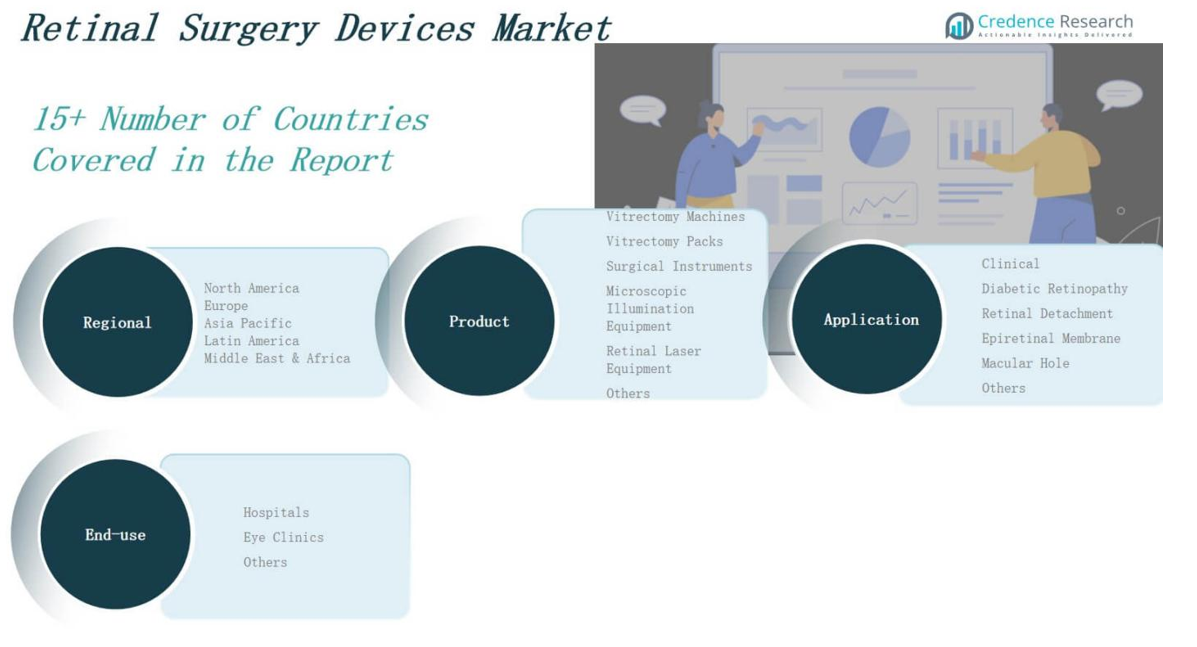CHAPTER NO. 1 : GENESIS OF THE MARKET
1.1 Market Prelude – Introduction & Scope
1.2 The Big Picture – Objectives & Vision
1.3 Strategic Edge – Unique Value Proposition
1.4 Stakeholder Compass – Key Beneficiaries
CHAPTER NO. 2 : EXECUTIVE LENS
2.1 Pulse of the Industry – Market Snapshot
2.2 Growth Arc – Revenue Projections (USD Million)
2.3. Premium Insights – Based on Primary Interviews
CHAPTER NO. 3 : RETINAL SURGERY DEVICES MARKET FORCES & INDUSTRY PULSE
3.1 Foundations of Change – Market Overview
3.2 Catalysts of Expansion – Key Market Drivers
3.2.1 Momentum Boosters – Growth Triggers
3.2.2 Innovation Fuel – Disruptive Technologies
3.3 Headwinds & Crosswinds – Market Restraints
3.3.1 Regulatory Tides – Compliance Challenges
3.3.2 Economic Frictions – Inflationary Pressures
3.4 Untapped Horizons – Growth Potential & Opportunities
3.5 Strategic Navigation – Industry Frameworks
3.5.1 Market Equilibrium – Porter’s Five Forces
3.5.2 Ecosystem Dynamics – Value Chain Analysis
3.5.3 Macro Forces – PESTEL Breakdown
3.6 Price Trend Analysis
3.6.1 Regional Price Trend
3.6.2 Price Trend by product
CHAPTER NO. 4 : KEY INVESTMENT EPICENTER
4.1 Regional Goldmines – High-Growth Geographies
4.2 Product Frontiers – Lucrative Product Categories
4.3 Application Sweet Spots – Emerging Demand Segments
CHAPTER NO. 5: REVENUE TRAJECTORY & WEALTH MAPPING
5.1 Momentum Metrics – Forecast & Growth Curves
5.2 Regional Revenue Footprint – Market Share Insights
5.3 Segmental Wealth Flow – Product & Application Revenue
CHAPTER NO. 6 : TRADE & COMMERCE ANALYSIS
6.1. Import Analysis by Region
6.1.1. Global Retinal Surgery Devices Market Import Volume By Region
6.2. Export Analysis by Region
6.2.1. Global Retinal Surgery Devices Market Export Volume By Region
CHAPTER NO. 7 : COMPETITION ANALYSIS
7.1. Company Market Share Analysis
7.1.1. Global Retinal Surgery Devices Market: Company Market Share
7.1. Global Retinal Surgery Devices Market Company Volume Market Share
7.2. Global Retinal Surgery Devices Market Company Revenue Market Share
7.3. Strategic Developments
7.3.1. Acquisitions & Mergers
7.3.2. New Product Launch
7.3.3. Regional Expansion
7.4. Competitive Dashboard
7.5. Company Assessment Metrics, 2024
CHAPTER NO. 8 : RETINAL SURGERY DEVICES MARKET – BY PRODUCT SEGMENT ANALYSIS
8.1. Retinal Surgery Devices Market Overview by Product Segment
8.1.1. Retinal Surgery Devices Market Volume Share By Product
8.1.2. Retinal Surgery Devices Market Revenue Share By Product
8.2. Vitrectomy Machines
8.3. Vitrectomy Packs
8.4. Surgical Instruments
8.5. Microscopic Illumination Equipment
8.6. Retinal Laser Equipment
8.7. Others
CHAPTER NO. 9 : RETINAL SURGERY DEVICES MARKET – BY APPLICATION SEGMENT ANALYSIS
9.1. Retinal Surgery Devices Market Overview by Application Segment
9.1.1. Retinal Surgery Devices Market Volume Share By Application
9.1.2. Retinal Surgery Devices Market Revenue Share By Application
9.2. Clinical
9.3. Diabetic Retinopathy
9.4. Retinal Detachment
9.5. Epiretinal Membrane
9.6. Macular Hole
9.7. Others
CHAPTER NO. 10 : RETINAL SURGERY DEVICES MARKET – BY END-USE SEGMENT ANALYSIS
10.1. Retinal Surgery Devices Market Overview by End-use Segment
10.1.1. Retinal Surgery Devices Market Volume Share By End-use
10.1.2. Retinal Surgery Devices Market Revenue Share By End-use
10.2. Hospitals
10.3. Eye Clinics
10.4. Others
CHAPTER NO. 11 : RETINAL SURGERY DEVICES MARKET – REGIONAL ANALYSIS
11.1. Retinal Surgery Devices Market Overview by Region Segment
11.1.1. Global Retinal Surgery Devices Market Volume Share By Region
11.1.2. Global Retinal Surgery Devices Market Revenue Share By Region
11.1.3. Regions
11.1.4. Global Retinal Surgery Devices Market Volume By Region
11.1.5. Global Retinal Surgery Devices Market Revenue By Region
11.1.6. Product
11.1.7. Global Retinal Surgery Devices Market Volume By Product
11.1.8. Global Retinal Surgery Devices Market Revenue By Product
11.1.9. Application
11.1.10. Global Retinal Surgery Devices Market Volume By Application
11.1.11. Global Retinal Surgery Devices Market Revenue By Application
11.1.12. End-use
11.1.13. Global Retinal Surgery Devices Market Volume By End-use
11.1.14. Global Retinal Surgery Devices Market Revenue By End-use
CHAPTER NO. 12 : NORTH AMERICA RETINAL SURGERY DEVICES MARKET – COUNTRY ANALYSIS
12.1. North America Retinal Surgery Devices Market Overview by Country Segment
12.1.1. North America Retinal Surgery Devices Market Volume Share By Region
12.1.2. North America Retinal Surgery Devices Market Revenue Share By Region
12.2. North America
12.2.1. North America Retinal Surgery Devices Market Volume By Country
12.2.2. North America Retinal Surgery Devices Market Revenue By Country
12.2.3. Product
12.2.4. North America Retinal Surgery Devices Market Volume By Product
12.2.5. North America Retinal Surgery Devices Market Revenue By Product
12.2.6. Application
12.2.7. North America Retinal Surgery Devices Market Volume By Application
12.2.8. North America Retinal Surgery Devices Market Revenue By Application
12.2.9. End-use
12.2.10. North America Retinal Surgery Devices Market Volume By End-use
12.2.11. North America Retinal Surgery Devices Market Revenue By End-use
12.3. U.S.
12.4. Canada
12.5. Mexico
CHAPTER NO. 13 : EUROPE RETINAL SURGERY DEVICES MARKET – COUNTRY ANALYSIS
13.1. Europe Retinal Surgery Devices Market Overview by Country Segment
13.1.1. Europe Retinal Surgery Devices Market Volume Share By Region
13.1.2. Europe Retinal Surgery Devices Market Revenue Share By Region
13.2. Europe
13.2.1. Europe Retinal Surgery Devices Market Volume By Country
13.2.2. Europe Retinal Surgery Devices Market Revenue By Country
13.2.3. Product
13.2.4. Europe Retinal Surgery Devices Market Volume By Product
13.2.5. Europe Retinal Surgery Devices Market Revenue By Product
13.2.6. Application
13.2.7. Europe Retinal Surgery Devices Market Volume By Application
13.2.8. Europe Retinal Surgery Devices Market Revenue By Application
13.2.9. End-use
13.2.10. Europe Retinal Surgery Devices Market Volume By End-use
13.2.11. Europe Retinal Surgery Devices Market Revenue By End-use
13.3. UK
13.4. France
13.5. Germany
13.6. Italy
13.7. Spain
13.8. Russia
13.9. Rest of Europe
CHAPTER NO. 14 : ASIA PACIFIC RETINAL SURGERY DEVICES MARKET – COUNTRY ANALYSIS
14.1. Asia Pacific Retinal Surgery Devices Market Overview by Country Segment
14.1.1. Asia Pacific Retinal Surgery Devices Market Volume Share By Region
14.1.2. Asia Pacific Retinal Surgery Devices Market Revenue Share By Region
14.2. Asia Pacific
14.2.1. Asia Pacific Retinal Surgery Devices Market Volume By Country
14.2.2. Asia Pacific Retinal Surgery Devices Market Revenue By Country
14.2.3. Product
14.2.4. Asia Pacific Retinal Surgery Devices Market Volume By Product
14.2.5. Asia Pacific Retinal Surgery Devices Market Revenue By Product
14.2.6. Application
14.2.7. Asia Pacific Retinal Surgery Devices Market Volume By Application
14.2.8. Asia Pacific Retinal Surgery Devices Market Revenue By Application
14.2.9. End-use
14.2.10. Asia Pacific Retinal Surgery Devices Market Volume By End-use
14.2.11. Asia Pacific Retinal Surgery Devices Market Revenue By End-use
14.3. China
14.4. Japan
14.5. South Korea
14.6. India
14.7. Australia
14.8. Southeast Asia
14.9. Rest of Asia Pacific
CHAPTER NO. 15 : LATIN AMERICA RETINAL SURGERY DEVICES MARKET – COUNTRY ANALYSIS
15.1. Latin America Retinal Surgery Devices Market Overview by Country Segment
15.1.1. Latin America Retinal Surgery Devices Market Volume Share By Region
15.1.2. Latin America Retinal Surgery Devices Market Revenue Share By Region
15.2. Latin America
15.2.1. Latin America Retinal Surgery Devices Market Volume By Country
15.2.2. Latin America Retinal Surgery Devices Market Revenue By Country
15.2.3. Product
15.2.4. Latin America Retinal Surgery Devices Market Volume By Product
15.2.5. Latin America Retinal Surgery Devices Market Revenue By Product
15.2.6. Application
15.2.7. Latin America Retinal Surgery Devices Market Volume By Application
15.2.8. Latin America Retinal Surgery Devices Market Revenue By Application
15.2.9. End-use
15.2.10. Latin America Retinal Surgery Devices Market Volume By End-use
15.2.11. Latin America Retinal Surgery Devices Market Revenue By End-use
15.3. Brazil
15.4. Argentina
15.5. Rest of Latin America
CHAPTER NO. 16 : MIDDLE EAST RETINAL SURGERY DEVICES MARKET – COUNTRY ANALYSIS
16.1. Middle East Retinal Surgery Devices Market Overview by Country Segment
16.1.1. Middle East Retinal Surgery Devices Market Volume Share By Region
16.1.2. Middle East Retinal Surgery Devices Market Revenue Share By Region
16.2. Middle East
16.2.1. Middle East Retinal Surgery Devices Market Volume By Country
16.2.2. Middle East Retinal Surgery Devices Market Revenue By Country
16.2.3. Product
16.2.4. Middle East Retinal Surgery Devices Market Volume By Product
16.2.5. Middle East Retinal Surgery Devices Market Revenue By Product
16.2.6. Application
16.2.7. Middle East Retinal Surgery Devices Market Volume By Application
16.2.8. Middle East Retinal Surgery Devices Market Revenue By Application
16.2.9. End-use
16.2.10. Middle East Retinal Surgery Devices Market Volume By End-use
16.2.11. Middle East Retinal Surgery Devices Market Revenue By End-use
16.3. GCC Countries
16.4. Israel
16.5. Turkey
16.6. Rest of Middle East
CHAPTER NO. 17 : AFRICA RETINAL SURGERY DEVICES MARKET – COUNTRY ANALYSIS
17.1. Africa Retinal Surgery Devices Market Overview by Country Segment
17.1.1. Africa Retinal Surgery Devices Market Volume Share By Region
17.1.2. Africa Retinal Surgery Devices Market Revenue Share By Region
17.2. Africa
17.2.1. Africa Retinal Surgery Devices Market Volume By Country
17.2.2. Africa Retinal Surgery Devices Market Revenue By Country
17.2.3. Product
17.2.4. Africa Retinal Surgery Devices Market Volume By Product
17.2.5. Africa Retinal Surgery Devices Market Revenue By Product
17.2.6. Application
17.2.7. Africa Retinal Surgery Devices Market Volume By Application
17.2.8. Africa Retinal Surgery Devices Market Revenue By Application
17.2.9. End-use
17.2.10. Africa Retinal Surgery Devices Market Volume By End-use
17.2.11. Africa Retinal Surgery Devices Market Revenue By End-use
17.3. South Africa
17.4. Egypt
17.5. Rest of Africa
CHAPTER NO. 18 : COMPANY PROFILES
18.1. Alcon
18.1.1. Company Overview
18.1.2. Product Portfolio
18.1.3. Financial Overview
18.1.4. Recent Developments
18.1.5. Growth Strategy
18.1.6. SWOT Analysis
18.2. Bausch & Lomb Incorporated
18.3. Carl Zeiss
18.4. Ellex Medical Lasers
18.5. Erbe Elektromedizin
18.6. Escalon Medicals
18.7. Iridex Corporation
18.8. Leica Microsystems GmbH
18.9. Lumenis
18.10 Nidek Co. Ltd.
18.11 Optos PLC
18.12 Second Sigh Medical Products
18.13 Synergetics USA Inc.
18.14 Topcon Corporation









